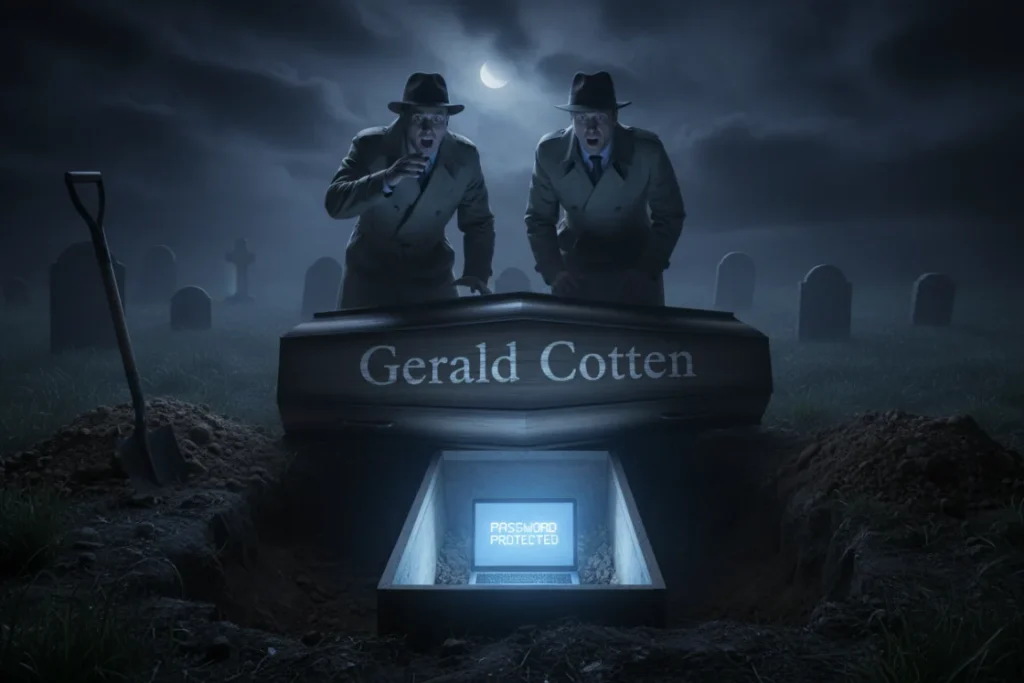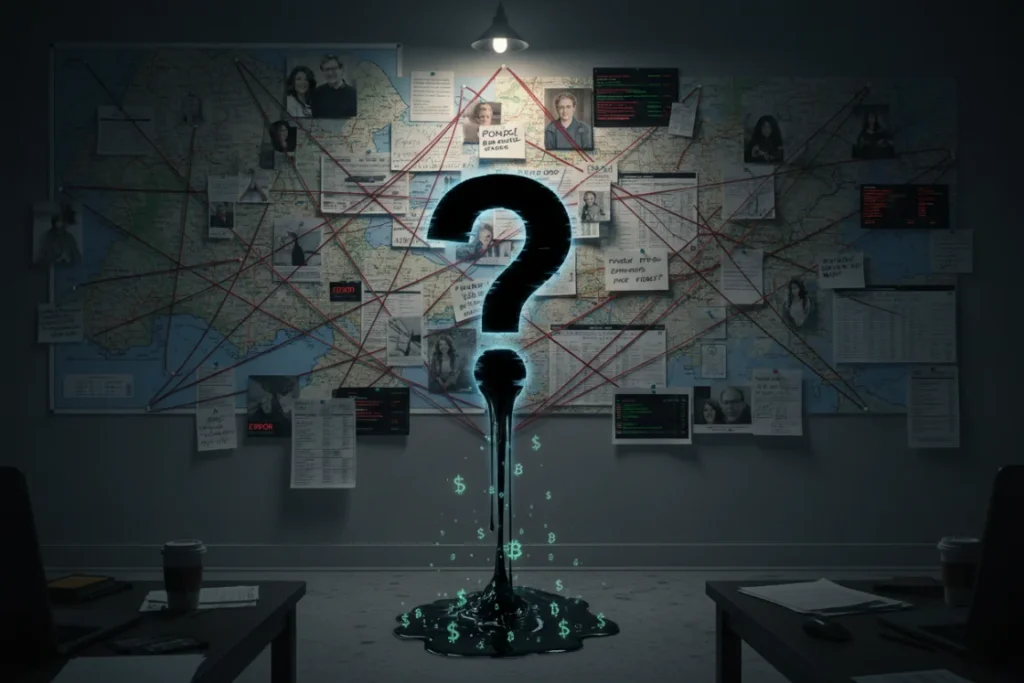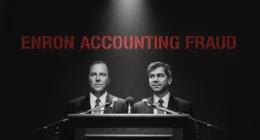The Death That Made No Sense
December 9, 2018. Jaipur, India. Gerald Cotten, 30-year-old CEO of Canada’s largest cryptocurrency exchange, suddenly died. The official cause: Complications from Crohn’s disease.
His death was tragic. Moreover, it was convenient. Additionally, it was suspicious.
Because Gerald was the only person who knew the passwords to QuadrigaCX’s cold wallets. These wallets held $215 million in customer cryptocurrency. Furthermore, he’d never shared the passwords with anyone. Not his wife. Not his business partners. Not even in a secure backup.
Therefore, when he died, the passwords died with him. Consequently, $215 million became permanently inaccessible. And 76,000 customers were left with nothing.
But here’s where the story gets strange. Very strange.
Within months, investigators discovered the cold wallets were mostly empty before Gerald “died.” Moreover, customer funds had been moved to exchanges and gambled away. Additionally, Gerald had been running a Ponzi scheme for years. Furthermore, his “widow” lived in a $12 million mansion.
Then came the real question: Did Gerald Cotten actually die? Or did he fake his death and disappear with $215 million?
This is the QuadrigaCX mystery. The strangest unsolved case in cryptocurrency history. Let’s investigate what really happened.

The Beginning: Canada’s Crypto King
Gerald Cotten: The Boy Genius
Gerald Cotten founded QuadrigaCX in 2013 at age 25. He was from British Columbia, Canada. Moreover, he was obsessed with cryptocurrency. Additionally, he saw an opportunity in Canada’s growing crypto market.
His pitch was simple: A Canadian exchange for Canadians. No need to use foreign platforms. Moreover, deposits in Canadian dollars. Additionally, customer service in English and French. Furthermore, government compliance and legitimacy.
The platform launched with basic features. However, it worked. Consequently, users joined. Moreover, trading volume grew steadily. By 2015, QuadrigaCX was Canada’s largest exchange.
Gerald cultivated a specific image:
- Young tech entrepreneur
- Cryptocurrency visionary
- Trustworthy Canadian businessman
- Accessible and responsive
He appeared at blockchain conferences. Moreover, he gave interviews about crypto’s future. Additionally, he positioned QuadrigaCX as the “safe” Canadian option.
People trusted him. That was his greatest weapon.
Jennifer Robertson: The Widow
In 2016, Gerald married Jennifer Robertson. She came from Nova Scotia. Moreover, she had no cryptocurrency background. Additionally, she worked in HR before marrying Gerald.
Jennifer later claimed she knew nothing about QuadrigaCX’s operations. She said Gerald kept business completely separate. Furthermore, she testified she didn’t even know he was the sole password holder.
This claim would become controversial. Because Jennifer received millions in assets from Gerald’s “estate.” Moreover, she lived in extreme luxury while customers lost everything. Additionally, investigators found her involvement went deeper than she admitted.
The Growth Years (2016-2018)
QuadrigaCX exploded during the 2017 crypto boom:
2016: $7 million in customer funds
2017: $150 million in customer funds
2018: $215 million in customer funds (peak)
The platform processed 20,000+ trades daily. Moreover, it had 363,000 registered users. Additionally, it became Canada’s go-to exchange. Furthermore, Gerald was becoming wealthy.
But behind the growth, a disaster was forming. Customer funds were disappearing. Moreover, Gerald was gambling on other exchanges. Additionally, withdrawals were being delayed. Furthermore, the platform was insolvent.
And Gerald was the only one who knew.

The Red Flags Nobody Noticed
The Withdrawal Problems
Starting in 2017, customers reported issues:
Common Complaints:
- Wire transfers are taking months
- Bitcoin withdrawals are delayed for weeks
- Support tickets ignored
- Vague excuses about “banking problems”
Gerald blamed banks for being anti-crypto. He claimed regulatory hurdles caused delays. Moreover, he said he was working to resolve issues. Customers believed him. They waited patiently.
The truth? QuadrigaCX didn’t have the money. Gerald had gambled it away on other exchanges. Consequently, he stalled withdrawals to hide insolvency. Moreover, he used new deposits to pay old withdrawals. Classic Ponzi mechanics.
The Sole Control Problem
Gerald maintained absolute control over everything:
- Only he knew cold wallet passwords
- Only he controlled exchange operations
- Only he accessed banking accounts
- Only he made financial decisions
No business continuity plan existed. Moreover, no backup protocols were in place. Additionally, no co-signers for wallets. Furthermore, no shared knowledge of systems.
This was insane for a platform holding $215 million. Yet nobody questioned it. Instead, they trusted Gerald completely.
The Luxury Spending
While customers waited for withdrawals, Gerald spent lavishly:
Personal Assets:
- $12 million mansion in Nova Scotia
- Private plane (Cessna 400)
- $600,000 yacht
- Luxury cars
- Multiple properties
- World travel
Where did this money come from? Supposedly, from early Bitcoin investments. However, investigators later found he’d been stealing customer funds for years.
The spending should have raised questions. A 30-year-old with that wealth from a Canadian crypto exchange? Suspicious. Yet nobody investigated until it was too late.

The Death in India
The Trip
November 2018. Gerald and Jennifer traveled to India. The stated purpose: Opening an orphanage for street children. Gerald had expressed interest in philanthropy.
They stayed at the Oberoi Rajvilas, a luxury resort in Jaipur. The trip seemed normal. Moreover, they posted photos on social media. Additionally, Gerald appeared healthy.
Then, suddenly, everything changed.
December 9: The Mysterious Illness
According to Jennifer’s later affidavit, Gerald became ill on December 8. Specifically, he experienced stomach pain and vomiting. She claimed it was related to his Crohn’s disease—a chronic inflammatory bowel condition.
The next day, December 9, his condition worsened rapidly. Therefore, they went to Fortis Escorts Hospital in Jaipur. Doctors attempted treatment. However, Gerald allegedly went into cardiac arrest. Moreover, resuscitation failed. Additionally, he was declared dead at 7:26 PM.
The official cause: Septic shock, cardiac arrest, and perforation of the intestine. All supposedly complications from Crohn’s disease.
Jennifer was devastated. Moreover, she immediately made arrangements to bring his body home. Additionally, she notified family and business associates.
But here’s the first strange thing: There was no autopsy in India. Moreover, the body was embalmed quickly. Additionally, cremation happened rapidly after returning to Canada. Furthermore, no independent medical examination occurred.
These facts would fuel conspiracy theories for years.
The Timeline Doesn’t Add Up
Later investigations revealed inconsistencies:
Questions Raised:
- Why go to India specifically?
- Why Jaipur (not a medical tourism destination)?
- Why no autopsy?
- Why rapid embalming?
- Why immediate cremation?
- Why were only a few people notified?
Moreover, Gerald’s will had been signed just 12 days before his death. Additionally, it transferred all assets to Jennifer. Furthermore, it was signed in a different country (Canada) right before the India trip.
The timing seemed too convenient. Almost planned.

The Collapse
January 2019: QuadrigaCX Freezes
One month after Gerald’s death, QuadrigaCX stopped processing withdrawals completely. Moreover, the platform went offline briefly. Additionally, customer service disappeared.
Then came an announcement: Due to Gerald’s death, the company couldn’t access cold wallets. He was the only one with passwords. Therefore, $215 million was locked permanently. Consequently, the exchange was filing for creditor protection.
The cryptocurrency world erupted in disbelief. How could a major exchange have a single point of failure? Moreover, why weren’t there backup protocols? Additionally, where was basic business continuity planning?
But the real shock came from the amount: $215 million. This included:
- $180 million in cryptocurrency
- $35 million in fiat currency
- 76,000 affected customers
People who’d trusted Canada’s “safest” exchange had lost everything.
The Widow’s Affidavit
Jennifer Robertson filed an affidavit explaining the situation. She claimed:
- Gerald was the sole password holder
- She had no access to cold wallets
- She knew nothing about exchange operations
- She’d tried everything to recover passwords
- The funds were genuinely inaccessible
She portrayed herself as an innocent widow. Moreover, she claimed to be helping investigators. Additionally, she said she wanted customers to recover their funds.
But this narrative was about to explode.

The Investigation
Ernst & Young Takes Over
The court appointed Ernst & Young (EY) as monitor for the bankruptcy proceedings. Their job: Investigate QuadrigaCX’s finances and attempt asset recovery.
What they found was shocking. Moreover, it was criminal. Additionally, it suggested Gerald’s death might not be what it seemed.
The Empty Cold Wallets
EY hired blockchain forensics experts. They traced QuadrigaCX’s supposed cold wallet addresses. The discovery was stunning:
The Truth:
- Most cold wallets had been empty since April 2018
- $215 million wasn’t locked; it was gone
- Funds had been moved to other exchanges months before Gerald’s death
- The “inaccessible” password story was a lie. This changed everything. If the wallets were empty before he “died,” then Gerald either:
- Stole the money and faked his death, or
- Stole the money and coincidentally died
Either way, QuadrigaCX was a fraud. Moreover, the “lost passwords” excuse was cover for theft. Additionally, customers had been defrauded long before the collapse.
The Trading History
Further investigation revealed Gerald’s trading activity:
What He Did:
- Moved customer funds to other exchanges
- Traded under fake accounts
- Gambled with massive leverage
- Lost spectacularly on bad trades
- Used new deposits to cover losses
Between 2016-2018, Gerald lost over $115 million trading on other exchanges. He was using QuadrigaCX as his personal gambling fund. Moreover, when he lost, customers bore the losses. Additionally, he covered shortfalls with new deposits.
This was fraud. Clear, intentional, criminal fraud.
Jennifer’s Knowledge
Investigators examined Jennifer’s role. Evidence suggested she knew more than she claimed:
Findings:
She received $12 million in assets from Gerald’s “estate”.
She lived in the mansion, knowing it was bought with stolen funds.
She signed off on some business transactions.
She benefited directly from the fraud.
However, prosecutors never charged her criminally. Instead, she agreed to settle civil claims. She returned $9 million in assets. Moreover, she kept $3 million for “living expenses.” Additionally, she faced no jail time.
Many victims felt this was an injustice. She’d lived in luxury on stolen money. Yet she walked away with millions while they got nothing.

The Fake Death Theory
Why People Don’t Believe He Died
Multiple factors fuel fake death theories:
Suspicious Circumstances:
- Convenient Timing: Dies right when the exchange collapses
- No Autopsy: Body never examined independently
- Rapid Cremation: Evidence destroyed quickly
- Recent Will: Signed days before death
- India Location: Country with documentation issues
- Empty Wallets: Prepared for exit before “death”
The Missing Millions:
- $115 million lost trading (documented)
- $100 million unaccounted for (never found)
- Wallets emptied months before death
- No trail to recovery
The Perfect Crime:
- Fake death in India
- Transfer assets to wife beforehand
- Disappear with $100+ million
- Wife keeps the mansion and the money
- No extradition risk if he’s “dead”
The Contradictions
Jennifer’s story had holes:
She Claimed:
Knew nothing about business. Surprised by missing funds. Trying to help with recovery.
Evidence Showed:
Received millions in assets. Signed business documents. Lived lavishly on customer funds. Kept most money after “settlement”.
Moreover, Gerald’s behavior before India was suspicious. He’d been moving money urgently. Additionally, he’d updated his will. Furthermore, he’d tied up loose ends. These are actions of someone preparing to disappear.
The Exhumation Request
In 2019, lawyers representing QuadrigaCX victims petitioned to exhume Gerald’s body. They wanted:
Independent autopsy, DNA verification, and Death confirmation.
The goal: Prove he actually died. Moreover, verify identity. Additionally, rule out a fake death scenario.
However, the request was denied. The judge ruled:
Exhumation is extreme. Death certificate sufficient. No concrete evidence of fraud. Family deserves privacy.
This decision frustrated victims. They felt the truth was being hidden. Moreover, they suspected someone was protecting Jennifer. Additionally, they believed Gerald might be alive somewhere.
The Victims
Life Savings Destroyed
Michael Ewing, 45: Lost $500,000—his entire retirement savings. “I trusted a Canadian exchange. I thought regulation protected us. I was wrong. Now I work at 45 when I should be retired.”
Tong Zou, 32: Lost $250,000. “I had just sold my business. Put proceeds in QuadrigaCX to buy crypto. Then Gerald died.’ My life’s work is gone.”
Konstantin Bodaghee, 28: Lost $100,000 saved for a house. “I’m a software developer. I should have known better. But I trusted the platform. Now I’ll never own a home.”
The Suicide
At least two confirmed suicides linked to QuadrigaCX. One victim lost his family’s entire savings—over $400,000. Moreover, he’d convinced his parents to invest. Additionally, he felt responsible for their loss.
He left a note: “Gerald Cotten took more than money. He took my future. I can’t face my family. This is the only way out.”
The Class Action
Victims filed a massive class action lawsuit. They sued:
QuadrigaCX (bankrupt)
Jennifer Robertson (partially liable)
Accounting firms (for missing red flags)
Banks (for enabling fraud)
However, recovery was minimal. The bankruptcy distributed $46 million to customers who’d lost $215 million. That’s 21 cents on the dollar.
Most victims accepted the loss. Moreover, they moved on with damaged finances. Additionally, many never invested in crypto again. Furthermore, their trust in Canadian regulation was destroyed.
The Netflix Documentary
“Trust No One: The Hunt for the Crypto King”
In 2022, Netflix released a documentary examining the QuadrigaCX mystery. The film explored:
- Gerald’s life and business
- The suspicious death
- The investigation findings
- Fake death theories
Moreover, it interviewed victims. Additionally, it spoke with investigators. Furthermore, it examined evidence suggesting fraud.
The documentary renewed interest in the case. Moreover, it brought new scrutiny to Jennifer. Additionally, it highlighted unanswered questions.
But it couldn’t answer the ultimate question: Is Gerald Cotten alive?

The Unanswered Questions
What Really Happened?
Three scenarios exist:
Scenario 1: He Actually Died
- Death was real, but coincidentally convenient.
- He’d planned to disappear, but died first.
- Jennifer was complicit in fraud.
- $100 million is hidden somewhere.
Scenario 2: Fake Death
- Arranged death in India (easy to falsify records).
- Paid off doctors and officials.
- Escaped with $100+ million.
- Living under a new identity somewhere.
Scenario 3: Murdered
- Someone killed him for the money.
- Made it look like a natural death.
- Took control of hidden funds.
- Jennifer is possibly involved.
Each scenario has evidence. Moreover, each has contradictions. Additionally, none can be proven conclusively.
The Missing $100 Million
Investigators traced $115 million in trading losses. However, QuadrigaCX held $215 million. Therefore, $100 million remains unaccounted for.
Where is it?
Possibilities:
Hidden in wallets nobody found.
Converted to cash and hidden.
Held by Gerald in untraceable form.
Stolen by someone else.
Lost genuinely through negligence.
This money could be anywhere. Moreover, if Gerald faked his death, he took it with him. Additionally, finding it would prove the fake death theory.
Will We Ever Know?
Probably not. Here’s why:
If He Died:
Body cremated (no DNA verification possible).
Evidence destroyed.
Indian records are unreliable.
The case is essentially closed.
If He’s Alive:
He’s got $100+ million to hide forever.
New identity in a non-extradition country.
Plastic surgery is possible.
No incentive to ever reveal the truth.
The perfect crime, if it is a crime, might stay perfect forever.
Lessons from QuadrigaCX
Red Flags to Watch
Single Point of Failure: If one person controls everything, it’s not a business—it’s a dictatorship. Moreover, it’s vulnerable to fraud. Additionally, death or disappearance destroys everything.
Withdrawal Delays: When exchanges slow withdrawals, they’re likely insolvent. Don’t wait for explanations. Instead, withdraw immediately.
No Transparency: QuadrigaCX never provided proof of reserves. Moreover, they never disclosed wallet addresses. Additionally, they refused independent audits.
Lavish Lifestyle: If the CEO lives like a millionaire while customers wait for withdrawals, something’s wrong. The money is coming from somewhere.
Banking Issues: Constant problems with banks often mean the exchange is violating laws or hiding activities.
Protection Rules
1. Never Trust One Person: Exchanges need multi-signature wallets. Moreover, they need multiple key holders. Additionally, they need succession plans.
2. Demand Proof of Reserves: Exchanges must prove they hold customer assets. Furthermore, verification should be independent. Moreover, it should be regular.
3. Minimize Exchange Time: Only keep funds on exchanges while actively trading. Otherwise, use self-custody. Remember: not your keys, not your coins.
4. Diversify Platforms: Never keep all crypto on one exchange. Spread risk across multiple platforms and personal wallets.
5. Watch for Warning Signs: Withdrawal delays, communication gaps, leadership changes—all suggest problems. Exit immediately when you see them.
6. Regulated Exchanges Only: Use platforms with proper licensing. Moreover, choose jurisdictions with strong enforcement. Additionally, verify regulatory status independently.

Where They Are Now
Gerald Cotten: Officially dead. Body cremated. No autopsy performed. Or possibly alive somewhere with a new identity and $100 million. Nobody knows for certain.
Jennifer Robertson: Living in Nova Scotia. Kept $3 million after the settlement. No criminal charges. Wrote a book about her experience. Maintains innocence.
The $100 Million: Missing. Never found. Possibly in hidden wallets. Or converted to cash. Or held by Gerald if he’s alive.
QuadrigaCX Victims: Received an average 21% recovery. Most financially devastated. Some bankrupted. At least two committed suicide.
Canadian Regulators: Tightened exchange rules. Required proof of reserves. Enhanced monitoring. But enforcement remains weak.
Crypto Industry: Moved toward greater transparency. Multi-signature became standard. Proof of reserves demanded. But new scams emerge constantly.
The Final Mystery
The QuadrigaCX mystery represents crypto’s darkest possibility: The perfect crime. If Gerald faked his death, he executed flawlessly:
- Built trust over the years
- Positioned as a legitimate businessman
- Stole funds gradually
- Prepared exit strategy
- Faked death in a perfect location
- Left wife to face the consequences
- Disappeared with fortune
Moreover, if he’s alive, he’s got every incentive to stay hidden. $100 million buys excellent security. Additionally, a new identity in the right country makes detection nearly impossible. Furthermore, as long as he’s “dead,” nobody’s really looking.
But here’s what’s truly horrifying: We’ll probably never know the truth. The body was cremated. Moreover, evidence was destroyed. Additionally, Indian records are incomplete. Furthermore, no autopsy occurred.
If he died naturally, it’s the most convenient timing in fraud history. If he faked his death, it’s the most successful cryptocurrency heist ever. Either way, 76,000 people lost $215 million. Moreover, most will never recover financially. Additionally, families were destroyed. Furthermore, at least two people died by suicide.
And Gerald Cotten—alive or dead—faces no consequences. His mansion stands in Nova Scotia. His yacht sits in a marina. Moreover, his wife kept millions. Additionally, his “legacy” is security theater and stolen funds.
The QuadrigaCX mystery isn’t just about missing Bitcoin. Instead, it’s about the fragility of trust. Moreover, it’s about how easily one person can destroy thousands of lives. Furthermore, it’s about how perfect crimes might actually exist.
Maybe Gerald Cotten is reading this article somewhere. Living under a new name. Spending stolen money. Laughing at how he fooled everyone.
Or maybe his body really does rest in a cemetery in Nova Scotia. And the $100 million sits in digital wallets nobody will ever access. Lost forever. Like tears in rain.
We’ll never know which version is true.
And that’s what makes QuadrigaCX the most haunting mystery in cryptocurrency history.
The man who took the keys to the grave. Or to paradise.
Resources
[1] “In the Matter of the Bankruptcy of QuadrigaCX.” Court filings and affidavits,
[2]Mystery as Quadriga crypto-cash goes missing
[3] Overview Report – Quadriga CX
12] Canada Revenue Agency. “Cryptocurrency Taxation Guidance.” Updated 2021.
Related reading(suggested)
[1]Mt. Gox Hack: The First Great Crypto Exchange Collapse
[2]Bitconnect Ponzi: Complete Timeline of $2.4 Billion Scam
[3]Celsius Network bankruptcy: Why 1.7 Million Users Lost Everything









